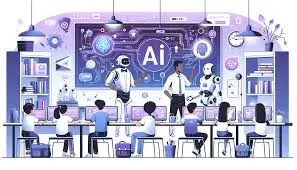In today’s fast-paced digital world, traditional methods of assessment are being transformed by cutting-edge technology. One of the most groundbreaking advancements in education is AI-powered adaptive testing. This innovative approach is revolutionizing how students are evaluated, providing personalized experiences that traditional exams simply cannot match. But what exactly is adaptive testing, and why is it such a game-changer? Let’s dive into this exciting world to uncover its potential and understand its impact on education.
What Is AI-Powered Adaptive Testing?

Imagine taking a test where the questions adjust to your abilities in real-time. That’s the magic of AI-powered adaptive testing. Using artificial intelligence, these tests analyze a student’s responses and adapt the difficulty level of subsequent questions. This dynamic approach ensures a more accurate measurement of knowledge, skills, and understanding.
How Does Adaptive Testing Work?
1. Initial Assessment
Every adaptive test begins with a question of medium difficulty. Based on the test-taker’s response, the system determines the next question’s complexity.
2. Real-Time Adjustments
If you answer correctly, the AI might give you a tougher question. Got it wrong? The system offers an easier one. This continuous adjustment tailors the test to your skill level.
3. Data Analysis
AI algorithms analyze patterns in your answers to assess not just what you know but how confident you are in your knowledge.
The Evolution of Assessment

From Paper to Digital
Traditional paper-based tests were static and one-size-fits-all. With the advent of digital tools, assessments became more accessible and efficient. Adaptive testing takes it a step further, making exams smarter and more responsive.
Why Static Tests Fall Short
Static tests often fail to measure a student’s true abilities. For instance, a gifted student might breeze through easy questions but never face challenges that reveal their potential. Conversely, struggling learners might be overwhelmed by overly difficult tests, leading to frustration. Adaptive testing bridges this gap.
Benefits of AI-Powered Adaptive Testing
1. Personalized Learning Journeys
Adaptive testing meets students where they are, providing a customized experience. It helps identify strengths and weaknesses more precisely than traditional assessments.
2. Reduced Test Anxiety
Knowing that questions adjust to their level can ease students’ nerves. They no longer face the daunting prospect of “failing” a one-size-fits-all exam.
3. Time Efficiency
Why spend hours answering questions below or above your ability level? Adaptive testing focuses on the sweet spot, saving time for both students and educators.
4. Immediate Feedback
With AI-powered systems, results are often instantaneous. This rapid feedback allows learners to pinpoint areas for improvement and teachers to adjust their strategies.
5. Enhanced Fairness
Unlike traditional tests that may favor specific learning styles, adaptive assessments offer a level playing field by tailoring questions to individual capabilities.
Key Technologies Behind Adaptive Testing
Also Read; Clicks and Scrolls: The Digital Revolution Transforming History Class
1. Artificial Intelligence (AI)
AI drives the adaptability of these tests by analyzing data and making real-time adjustments. It ensures every question is meaningful and relevant to the test-taker’s abilities.
2. Machine Learning (ML)
Through ML, adaptive testing systems improve over time, learning from vast datasets to make more accurate predictions and adjustments.
3. Natural Language Processing (NLP)
NLP enables tests to include complex, open-ended questions by understanding and evaluating written or spoken responses.
4. Cloud Computing
Cloud technology ensures seamless data storage and accessibility, making it possible to deploy adaptive tests on a global scale.
Applications of Adaptive Testing
1. K-12 Education
Schools can use adaptive tests to track student progress and tailor lesson plans.
2. Higher Education
Colleges are incorporating adaptive testing for entrance exams and placement tests, ensuring students are placed in courses suited to their abilities.
3. Professional Certification
Industries like IT, healthcare, and finance use adaptive assessments to evaluate competency and certify professionals efficiently.
4. Employee Training
Companies leverage adaptive testing to upskill employees, ensuring training programs are targeted and effective.
Challenges and Criticisms
1. Data Privacy Concerns
Collecting and analyzing student data raises valid concerns about privacy and security.
2. Accessibility Barriers
Not all students have equal access to the technology required for adaptive testing, which can widen the digital divide.
3. Over-Reliance on AI
While AI is powerful, it’s not infallible. Misinterpretations or biases in algorithms can lead to unfair outcomes.
How Educators Can Prepare for the Shift
1. Embrace Technology
Teachers should familiarize themselves with adaptive testing platforms and understand how to interpret the results.
2. Focus on Continuous Learning
Professional development programs can help educators stay updated on the latest advancements in AI-powered assessment.
3. Promote Digital Literacy
Students need the skills to navigate digital platforms confidently. Introducing these tools early can ease the transition.
The Role of Gamification in Adaptive Testing
Gamification adds an element of fun to adaptive assessments. By incorporating game-like features such as badges, leaderboards, and rewards, these tests can boost engagement and motivation.
The Global Impact of Adaptive Testing
1. Bridging Educational Gaps
In under-resourced areas, adaptive testing can provide personalized learning opportunities, addressing individual needs without requiring extensive human intervention.
2. Supporting Multilingual Learners
AI-powered platforms can deliver tests in multiple languages, catering to diverse student populations.
3. Enhancing Lifelong Learning
Adaptive testing is not just for students. Adults pursuing continuous education can benefit from these tailored assessments.
What the Future Holds
1. Integration with Virtual Reality (VR)
Imagine an adaptive test that immerses you in a VR environment, making the experience both interactive and engaging.
2. Emotion Recognition
Future systems might use facial recognition to gauge a test-taker’s emotions, adjusting questions to reduce stress or frustration.
3. Collaboration with AI Tutors
AI tutors could complement adaptive tests, offering real-time explanations and guidance.
Conclusion
AI-powered adaptive testing is more than just a technological trend—it’s a paradigm shift in education and assessment. By personalizing the learning experience, these tests empower students and educators alike, ensuring that no one is left behind. While challenges remain, the potential benefits far outweigh the drawbacks. As we look ahead, it’s clear that adaptive testing will play a pivotal role in shaping the future of education.
FAQs
1. What is the main advantage of AI-powered adaptive testing?
It provides a personalized assessment experience, tailoring questions to match a student’s abilities and offering more accurate insights into their knowledge.
2. How does adaptive testing reduce test anxiety?
By adjusting the difficulty level to a student’s skillset, it removes the pressure of encountering overly challenging questions, making the process less intimidating.
3. Is adaptive testing suitable for all age groups?
Yes! Adaptive testing is versatile and can be used for K-12 students, college learners, and even professionals undergoing training.
4. Are there any downsides to adaptive testing?
Challenges include data privacy concerns, potential bias in AI algorithms, and accessibility issues for students without reliable technology access.
5. How can educators integrate adaptive testing into their classrooms?
Teachers can start by exploring user-friendly platforms, undergoing training on adaptive technologies, and using results to inform personalized teaching strategies.


